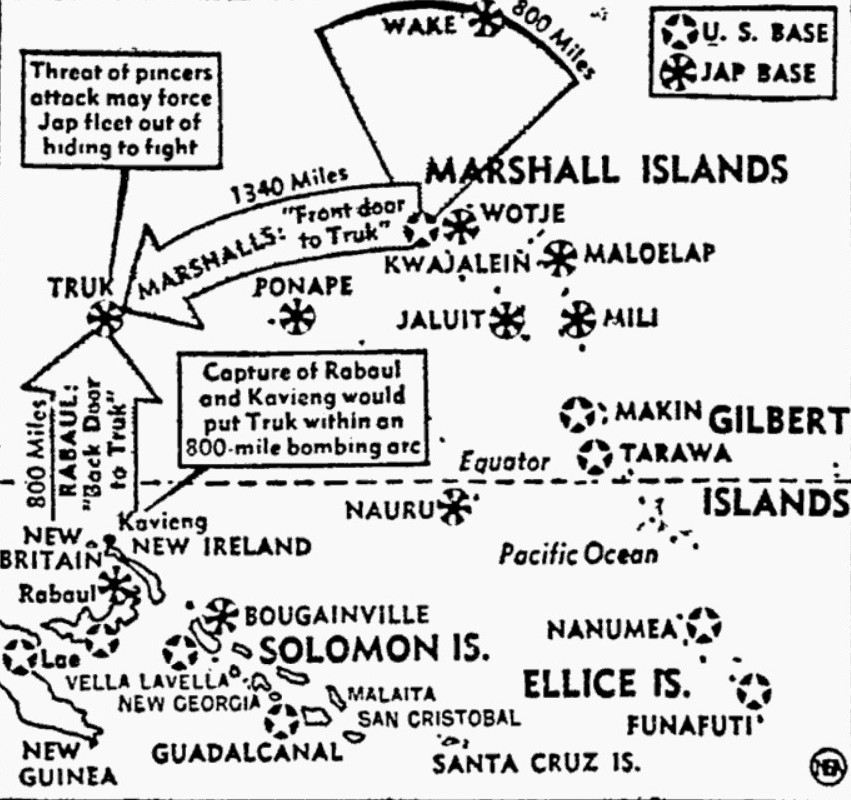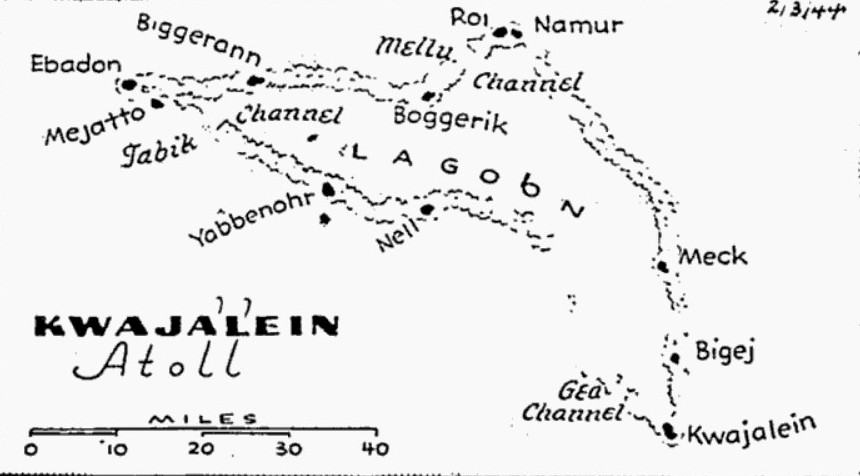The Pittsburgh Press (February 3, 1944)
AMERICANS OVERRUN ATOLL
Kwajalein Japs driven into two pockets on islets
Marshalls invaders seize half of last enemy-held airfield; complete conquest may come in few hours
By William F. Tyree, United Press staff writer
Capture of Kwajalein and the remaining fortified atolls of the Marshall Islands, together with seizure of Kavieng and tottering Rabaul would place Truk, Japs’ main Pacific bastion, in the center of pincers as shown on the map.
Remnants of Jap forces on Kwajalein Atoll have been squeezed by U.S. invaders of the Marshalls into two pockets on Namur and Kwajalein Islands, at the northern and southern ends of the atoll.
Mass evacuation of Tokyo reporter
London, England (UP) –
A mass evacuation of Tokyo’s eight million residents is in full swing, in anticipation of large-scale Allied air raids on the Japanese capital, the German DNB News Agency said today in a dispatch from Tokyo.DNB said word of the evacuation came from the city’s mayor Shigeo Ōdachi, who declared “we expect air attacks and have take measures accordingly.”
A Japanese broadcast reported yesterday said the partial evacuation of Kyoto and Yokosuka had also been ordered, bringing to seven the number of Jap cities in which “depopulation measures” are being taken. The others, along with Tokyo, are Yokohama, Osaka, Kobe and Nagoya.
Pearl Harbor, Hawaii –
U.S. Marines and infantry, backed by tanks and the heaviest air and naval bombardment of the Pacific War, have seized half of the last enemy-held airfield in Kwajalein Atoll in the heart of the Marshalls and begun battles of extermination against Japanese remnants, front dispatches said today.
With the only enemy opposition in strength confined to a shrinking pocket at either end of the 66-mile-long atoll, complete conquest of Kwajalein, first pre-war Jap territory invaded by the Americans, was in sight and perhaps only a matter of hours away.
The capture of Roi Island, northern hinge of the atoll and site of its main airfield, was announced yesterday and other sources revealed that the invasion forces were occupying most of the remainder of the 90 islands and islets in the atoll as fast as they can get ashore.
Squeezed into corners
The bulk of the Jap defenders were being squeezed back into narrow corners on the only two remaining strategically-important islands in the atoll, Kwajalein and Namur, where they were hammered mercilessly by land artillery, naval batteries ranging up to 16-inch guns and blockbuster aerial bombs.
RAdm. Taneysugu Sosa, in a Tokyo propaganda broadcast apparently designed to explain away the lack of effective opposition to the U.S. landings, said Japan “does not mind if America’s invasion forces move further because in that case it can severely trounce them at one stroke at the right moment.”
Third of Kwajalein taken
Percy Finch, representing the combined Allied press aboard the joint expeditionary force flagship, reported that the Army’s 7th Infantry Division had captured one third of Kwajalein Island, at the southern tip of the atoll, by midday yesterday and driven the surviving enemy troops to stronger defense positions in the narrow eastern end.
At last reports, Mr. Finch said, the invaders had advanced halfway across the airstrip inland with the aid of newly-landed tanks.
He revealed that the Army troops had splashed ashore on Kwajalein from nearby coral islets without opposition after 5,000 tons of shells and bombs literally had pulverized defenses the Japs had built over a period of 20 years.
Concrete walls disappear
Mr. Finch said:
Two concrete beach walls and disappeared. There was no sign of massive concrete tank obstacles. Formidable pillboxes of concrete and beach coral stones had been ripped open and flattened so thoroughly that the features of the defense line built by the Japs to halt invaders were indistinguishable.
Massed artillery fire from Enubuj Islet (two miles southwest of Kwajalein) was so terrific that the islet was hidden in a cloud of smoke from the rapid-firing guns.
Kwajalein, a crescent-shaped island two and a half miles long and a third of a mile wide, was the site of the main headquarters for the atoll and controlled the southern entrance for its lagoon, the largest of its kind in the world and capable of anchoring a huge naval fleet.
Japs at the northern end of the atoll were hemmed into a corner of the northeastern beach on Namur, where the enemy had built dumps to supply the triangular airfield on adjoining Roi Island.
Mr. Finch said liquidation of the Jap pocket on Namur was expected “momentarily.”
Navy Seabees, fighter construction workers, were believed already converting the bomb and shell-battered Roi Airfield into a base for further operations in the Marshalls and perhaps attacks on Truk, Japan’s “Pearl Harbor” only 940 miles to the east.
Casualties ‘moderate’
U.S. casualties continued “moderate,” Adm. Chester W. Nimitz, commander of the Pacific Fleet, reported in his communiqué yesterday. Jap casualties were not estimated, though Adm. Nimitz revealed that several dozen prisoners had been captured on Kwajalein.
Naval observers attributed the success of the invasion to the fact that the enemy apparently had been taken by surprise and to the terrific bombardment laid down by the largest naval striking force ever assembled in any ocean.
A spokesman for Adm. Nimitz said the forces which landed on Kwajalein found the huge fires started by the naval bombardment more of an obstacle than the rifle, machine-gun and some mortar fire which they encountered inland.
Disclosure that the invasion force had suffered no naval losses was taken as a tribute to the effectiveness of the bombardment of enemy airfields and the reluctance of the Jap fleet to risk an engagement.

